Clean up the grid and electrify everything
Dispatch from the NW Energy Coalition 2016 Clean & Affordable Energy Conference
Amid uncertainty about what recent election results will mean for environmental policy and the fate of the planet, a remarkable clarity pervaded the NW Energy Coalition Clean & Affordable Energy conference this past Thursday in Portland.
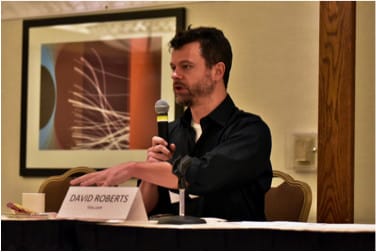 David Roberts, Vox energy and climate columnist and the conference’s keynote speaker, opened the day by reminding an audience of more than two-hundred that, regardless of coming battles and possible changes in energy and environmental policy both in Washington DC and in the Northwest, there remains a simple imperative. If we are to avoid doing catastrophic damage to the planet and to ourselves, “we must clean up the grid and electrify everything.”
David Roberts, Vox energy and climate columnist and the conference’s keynote speaker, opened the day by reminding an audience of more than two-hundred that, regardless of coming battles and possible changes in energy and environmental policy both in Washington DC and in the Northwest, there remains a simple imperative. If we are to avoid doing catastrophic damage to the planet and to ourselves, “we must clean up the grid and electrify everything.”
In a room occupied by players with divergent interests – environmental advocates, utility executives, clean energy businesspeople, advocates for low income communities, state regulators, and indian tribes to name a few – everyone accepted Roberts’ admonition, although some may have taken his words more literally than others. Still, when Roberts went on to declare that the way forward would require utilities – entities that are not generally known for their entrepreneurial spirit – to be “heroic”, he was eagerly seconded by Puget Sound Energy CEO, Kimberly Harris, who participated in the day’s first panel that explored what “the utility of the future” would look like.
CEO’s and Decision-makers Discuss the Utility of Tomorrow
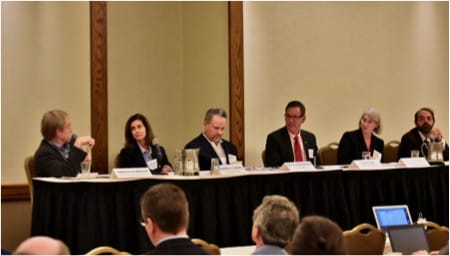 Participating in a panel moderated by Angus Duncan of the Natural Resources Defense Council, Harris dismissed concerns about possible changes in federal policy saying that PSE’s mission to meet the needs and desires of its customers who are among the nation’s most environmentally conscious, will remain unchanged. After identifying areas in which PSE is working to reduce pollution and carbon emissions, such as maritime transportation, Harris went on to express hope that her company and other utilities can be given greater legal and regulatory latitude to pursue other innovative opportunities for emission reductions and improved energy efficiency.
Participating in a panel moderated by Angus Duncan of the Natural Resources Defense Council, Harris dismissed concerns about possible changes in federal policy saying that PSE’s mission to meet the needs and desires of its customers who are among the nation’s most environmentally conscious, will remain unchanged. After identifying areas in which PSE is working to reduce pollution and carbon emissions, such as maritime transportation, Harris went on to express hope that her company and other utilities can be given greater legal and regulatory latitude to pursue other innovative opportunities for emission reductions and improved energy efficiency.
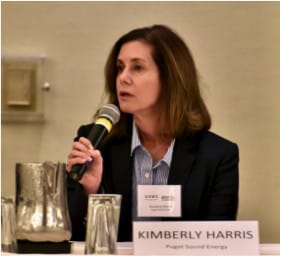
But, Bob Jenks of Oregon’s Citizen’s Utility Board, pointed out that, while many of these efforts are laudable and productive, business opportunities and investments don’t always align with the goal of reducing greenhouse emissions and may not produce equitable outcomes. More troubling, Jenks argued, is that we often don’t have the analytic tools that are necessary to properly assess whether new initiatives are aligned with social goals and how productive they’ll be.
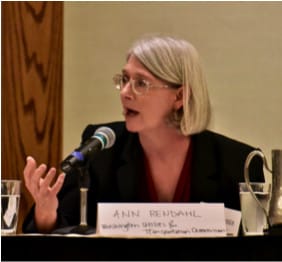
A day that started with consensus about the need to clean up the energy system had begun to identify hurdles to achieving that goal. Chief among them:
- Insufficient and, in some cases, counterproductive economic incentives for utilities and other players in the energy space.
- Legal obligations and limitations that may provide important protections, but which may also stifle innovation and impede our ability to address rapidly evolving needs.
- A methodological inability to properly assess, in a timely manner, new initiatives and emerging technologies that may play important roles in solving the puzzle.
- A lack of regional planning, evaluation, and coordination to be sure that the players in an increasingly interdependent marketplace are properly aligned and operating in concert.
Next-generation energy efficiency
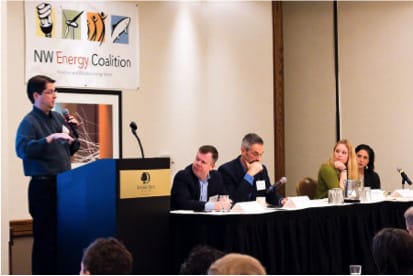
In a panel hosted by Greg Stiles of Ecova, Rob Harmon of the MEETS Coalition presented a financial model that creates financial incentives for utilities, energy efficiency service providers, and building owners to pursue deep energy efficiency by assuring that building tenants continue to pay what they would have paid if the building they occupy were not made energy-efficient. In this way, the tenants get the energy they need at no increased cost, the utility maintains revenue and the money that energy efficiency saves is shared by the parties that make investments to make the building energy efficient.
Performance-based financial models have an important role to play as efforts to achieve whole-building efficiency are showing a startling capacity for increased savings.
The New Buildings Institute (NBI) tracks the proliferation of Zero Net Energy buildings in the U.S. These are buildings that, through the enhanced use of solar, other on-site renewable generation, and extensive energy efficiency measures, actually produce more electricity than they consume. Ralph DiNola of NBI provided data showing an accelerating trend of more Zero Net Energy buildings in almost every state.
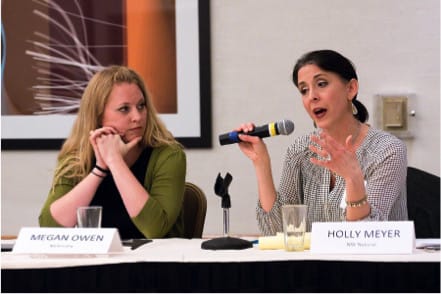
The challenge for energy efficiency in both new and existing buildings is that the financial return isn’t always sufficient or realized quickly enough to motivate owners to take action. And municipal building codes also create inadvertent obstacles. So, even if the new financial and performance based models can solve the financing challenge, more remains to be done.
In addition, other segments of the marketplace are in need of assistance as well. As Holly Braun Meyer of NW Natural explained, another market in which energy efficiency upgrades can achieve the greatest results and do the most good is among low-income, single family homeowners. In addition to being wasteful of energy, many of these homes are also in disrepair making it necessary to perform both efficiency upgrades and repairs, which homeowners often can’t afford without assistance. It’s an area in which more innovation in delivery of weatherization and energy efficiency services is needed. Braun noted that, beyond providing financial and environmental benefits, energy efficiency efforts in low-income communities make important contributions to basic human needs for comfort and health.
What the election results mean for renewable energy
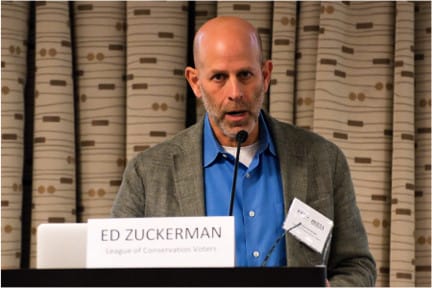
Zuckerman pointed out that in states that had environmental or clean energy initiatives on the ballot, most of them won, the notable exception being Washington where the revenue neutral carbon tax was soundly rejected. The lesson of the carbon tax failure, Zuckerman asserted, is the need for coalition-building and, when tax increases are part of the proposal, tying the way in which resulting revenue will be spent to the activity being taxed, something that Washington’s carbon tax initiative failed to do.
Turning to state races around the Northwest, Zuckerman noted that there was little change in either governorships or legislatures. No house majorities changed hands in any Northwest state and the minor changes in legislative seat counts that did occur are not expected to significantly alter the legislative calculus in Oregon, Washington, Idaho, or Montana.
Increasing demand for clean energy services
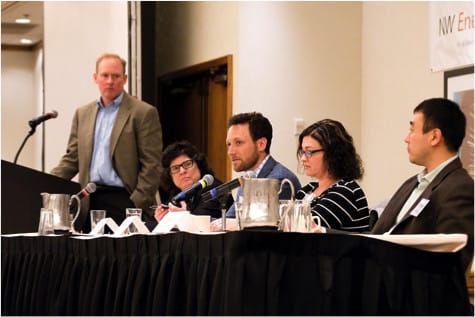
Observing that even in a city that has done as much as Seattle, we’re currently reaching only a fraction of the buildings that can benefit greatly from energy efficiency upgrades, Susan Wickwire of the Seattle 2030 District, made the case for cities to provide more incentives for building owners and developers to invest in energy efficiency.
Jake Oster of EnergySavvy argued that the potential value of such incentives is growing rapidly, citing the spread of savings measurement technology and associated pay for performance programs.
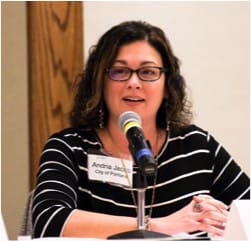
While all four panelists agreed on the need for increased funding sources for energy efficiency in community settings, they were also in agreement on the urgent need to adapt tools – data capture, measurement techniques, and reporting practices – to provide homeowners and business owners with the information needed to make rational economic choices about energy efficiency.
The point was illustrated by the story of an audience member who was unable to find a real estate appraiser who was able to appraise his LEED certified home because there is insufficient market information available. And Jimmy Jia described the struggles small business owners have in assessing their cash flow and relating it to energy costs and possible energy efficiency expenditures.
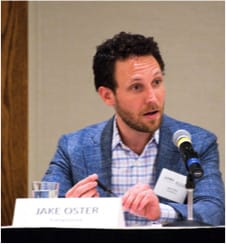
In all of these respects, while tools can be made available from the bottom up, it was agreed that leadership needs to come from the top down in the form of policy from officeholders and regulators and in the form of leadership from utilities who will need the proper incentives in order to make the investment.
The Columbia River Basin Environmental Impact Statement: Energy System Impacts and Opportunities
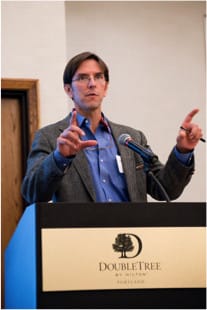
Bogaard began by noting that given the judge’s decision it is likely that there will be a change to operation of the Columbia and Snake River hydrosystem. He then summarized the current hearing process convened by the U.S. Army Corps of Engineers, the Bureau of Reclamation, and BPA, which will be completed in January 2017, and asked the panelists for their assessments.
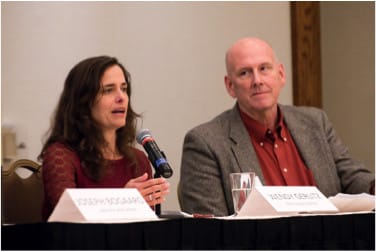
Gray refocused the issue to the challenge of replacing the functions currently performed by the dams. And Fazio presented a series of slides explaining the dams’ operation and the different functions they perform in order to contribute both energy and stability to the electric grid.
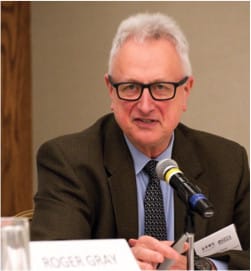
While there was a spirited discussion about the functions and options for providing those services, all three speakers agreed that the NEPA process should provide greater access to data and details on operations and capital costs as well as power replacement costs. A thorough evaluation of the benefits of the existing system and alternatives should also be apart of the environmental impact statement.
Devising a low-carbon infrastructure for the Northwest
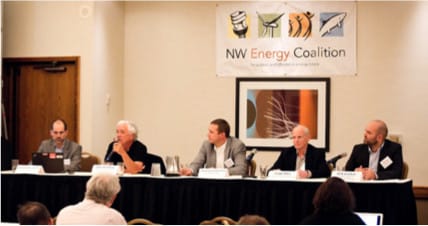
In addition to tackling the technical challenges of capacity, reliability, and cost and the challenge of anticipating technological and societal changes for the next couple of decades, the California study also had to deal with the four challenges mentioned earlier in this document:
- The need for appropriate economic incentives for utilities and other players
- Updating of laws and regulations to reflect the new imperatives, new technologies, and the roles that various players will need to play
- The need for improved data capture, management, and analysis tools and techniques to drive public policy and private investment decision making
- The need for regional planning, evaluation, and coordination processes to coordinate and inform the IRP processes of individual utilities
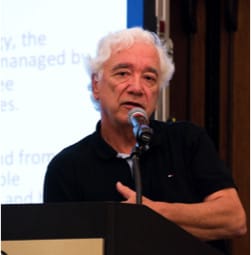
In answer to McCarthy’s question about whether natural gas has a role in California’s energy future as envisioned by the study, Caldwell replied that it does, but will be focused on providing flexibility in the grid to meet 2 to 6-hour demand peaks. That might be one of the ways in which the Northwest experience deviates from California according to Yourkowski and Kujala who suggested that hydro is well suited to perform the balancing function and is abundant in the Northwest.
When asked about challenges to conducting the study and to implementing its findings, Caldwell identified three primary issues:
- First, existing models are not well-suited to the task of comparing the value and efficacy of fossil fuel-generated energy, which carries a high variable cost with renewables that effectively carry no variable cost, and especially with energy efficiency which carries a negative variable cost.
- Institutional and systemic inertia is “immense” and the changes that will be required in infrastructure will force many players to function differently than they do today. Meanwhile, new ones will come into existence as others disappear altogether.
- Some variables are just really hard predict such as how distributed energy is going to evolve and the extent of the contribution that technology-enabled demand response techniques might provide.
All panelists agreed on the urgent need for this kind of study for the Northwest and the roadmap it would provide.
A few of the panelists prepared brief presentations, which follow:
JIMMY JIA — DISTRIBUTED ENERGY MANAGEMENT
WENDY GERLITZ — NW ENERGY COALITION
JOHN FAZIO — NW POWER & CONSERVATION COUNCIL
ED ZUCKERMAN — LEAGUE OF CONSERVATION VOTERS

